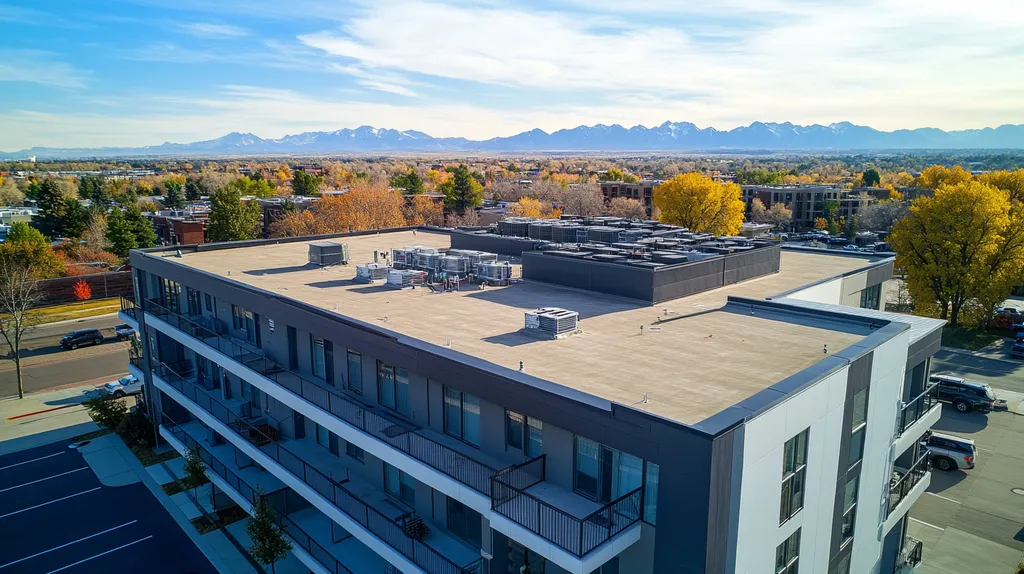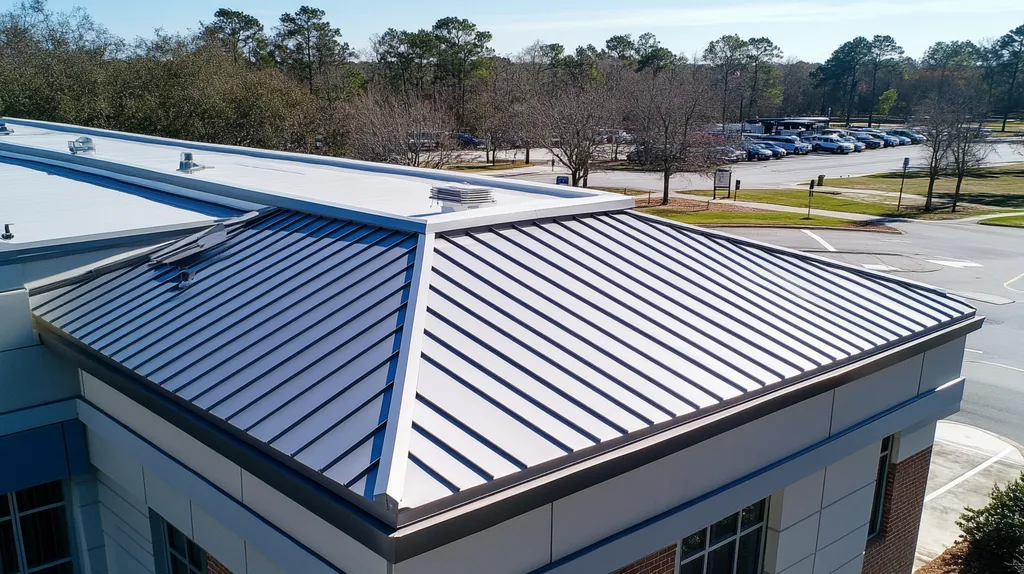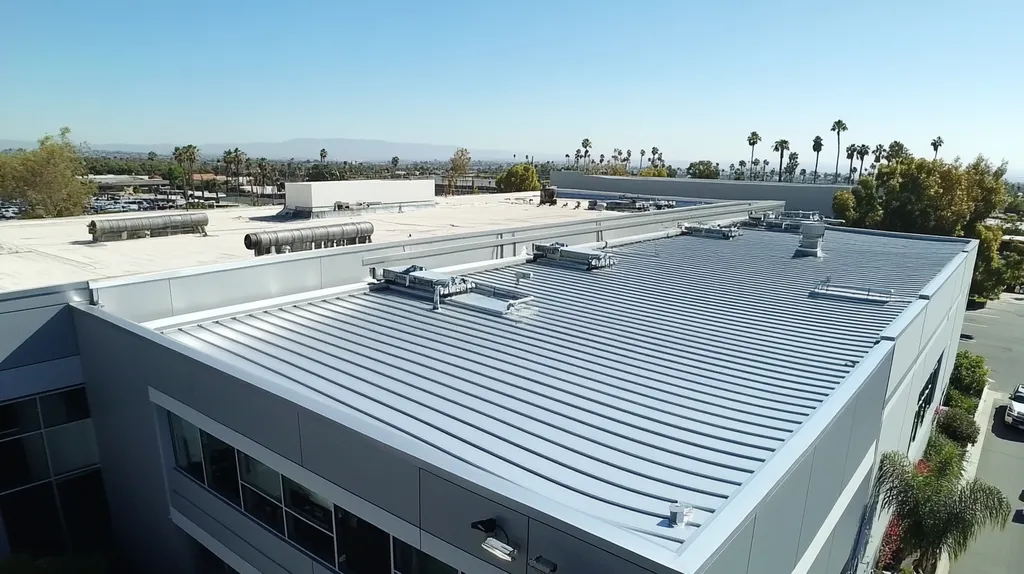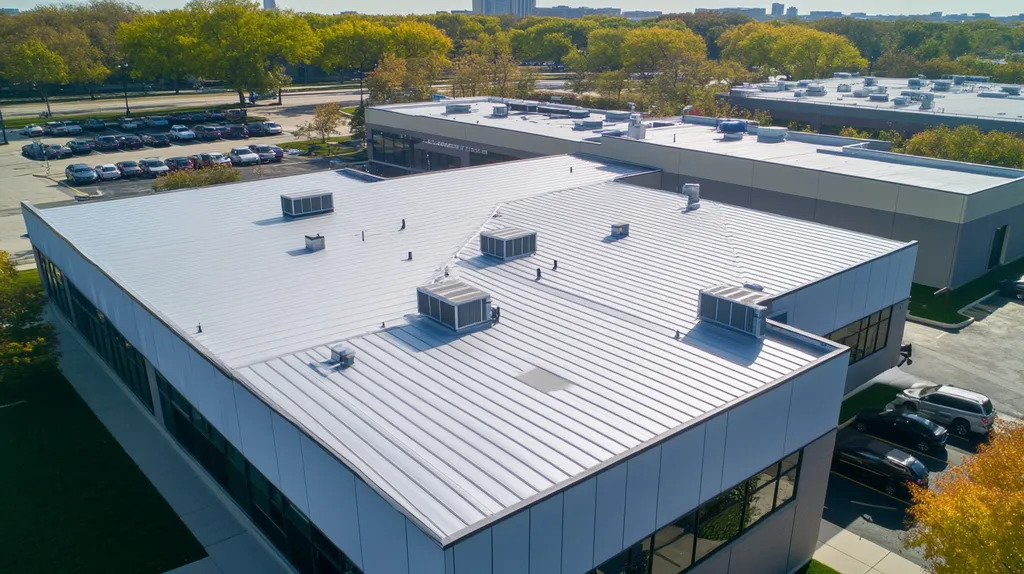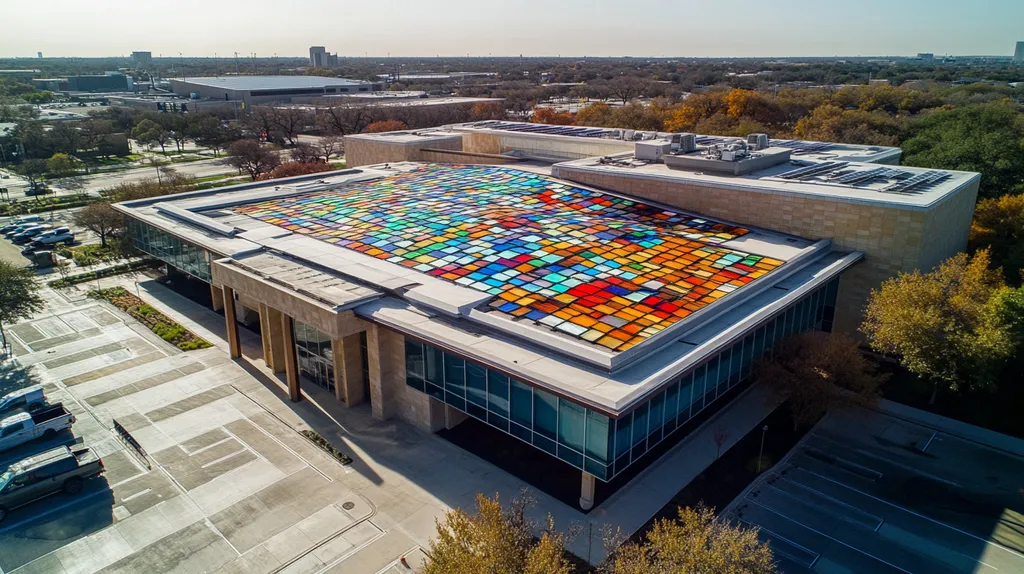Every year, industrial facilities lose millions in productivity and repairs due to preventable roofing issues, with 75% of structural failures traced back to inadequate assessment practices.
For facility managers, understanding how to evaluate roof condition isn’t just about maintenance—it’s about protecting critical operations, valuable inventory, and worker safety.
This comprehensive guide breaks down the essential components of industrial roof assessment, from basic terminology to advanced diagnostic techniques, helping you make informed decisions about your facility’s most important protective system.
SECTION 1: THE BASICS EXPLAINED
Comprehensive roof assessments serve as the foundation of effective facility management, yet studies show that 75% of commercial roof failures could have been prevented through proper evaluation. These failures lead to billions in damage annually, affecting everything from inventory to operations. Understanding the fundamentals of roof assessment isn’t just about maintenance—it’s about protecting your facility’s most critical defensive system.
What It Is (In Plain Language)
A roof assessment is a systematic evaluation that examines every component of your roofing system. It’s similar to a medical checkup, where professionals investigate both obvious symptoms and potential hidden problems.
During an assessment, inspectors examine surface conditions, structural components, and water management systems. They look for signs of stress, deterioration, or damage that could compromise the roof’s integrity.
Common issues found during inspections include cracks, bulges, ponding water, rust, punctures, debris accumulation, biological growth, shrinkage, and drainage problems. These indicators help determine both immediate concerns and potential future failures.
The assessment process covers penetrations, drainage systems, seams, fasteners, substrate firmness, and interior conditions to create a complete picture of roof health. (source: Procore)
Why It Matters (To Your Building)
Your roof represents roughly 10% of your building’s total cost but protects 100% of your assets. When roof systems fail, the cascade of problems affects everything below—from inventory to equipment to daily operations.
Financial implications extend far beyond repair costs. Water infiltration can damage electrical systems, compromise structural integrity, and create unsafe working conditions that halt operations.
Insurance companies increasingly require documented roof assessments. Without proper documentation, facilities risk claim denials and increased premiums.
Regular assessments help predict maintenance needs, allowing facilities to budget effectively and prevent emergency repairs that cost 3-5 times more than planned maintenance.
How It Works
Professional roof assessments follow a structured approach that begins with historical review. Inspectors examine past repairs, modifications, and documented issues to understand the roof’s history.
The physical inspection includes both exterior and interior examinations. Technicians use advanced moisture detection equipment, thermal imaging, and core sampling to identify hidden problems.
Documentation plays a crucial role, with detailed photographs and measurements recording current conditions. This creates a baseline for future comparisons and helps track degradation rates.
The final assessment report provides a detailed analysis of findings, prioritized recommendations, and budget projections. This document becomes your roadmap for maintaining roof integrity and planning future investments.
SECTION 2: PRACTICAL APPLICATIONS
Every year, industrial facilities lose millions in productivity and repairs due to preventable roof issues. Understanding when and how to leverage roof assessments can mean the difference between proactive maintenance and catastrophic failure. Through systematic evaluation, facility managers can protect assets, maintain operations, and extend roof life while optimizing their maintenance budgets.
Common Uses & Examples
Modern roof assessments employ advanced diagnostic tools to detect issues before they become visible problems. Non-invasive testing methods like electronic leak detection can identify concealed moisture that threatens roof integrity, while specific testing approaches accommodate different roofing materials.
Manufacturing facilities regularly use assessments to verify that roof systems can support heavy mechanical loads and resist chemical exposure. These evaluations ensure that production areas remain protected from environmental threats that could compromise product quality.
Distribution centers utilize roof surveys to maintain precise climate control for inventory protection. Regular assessments help identify thermal bridges and insulation failures that could affect storage conditions.
Data centers depend on comprehensive roof evaluations to protect sensitive electronic equipment. These assessments focus particularly on preventing water infiltration that could lead to catastrophic system failures. (source: Hoffmann Architects)
When You Need It Most
Timing roof assessments strategically helps maximize their effectiveness. Schedule evaluations before extreme weather seasons to identify vulnerabilities and implement preventive measures.
Post-storm inspections become critical after severe weather events. Even when visible damage isn’t apparent, high winds and hail can compromise roofing systems in ways that only professional assessment can detect.
Building modifications or equipment installations require immediate roof evaluation. Adding HVAC units, solar panels, or other rooftop equipment changes load distributions and creates new penetration points that demand careful assessment.
Insurance renewals and property transactions typically trigger the need for detailed roof surveys. These assessments provide documentation that can affect coverage terms and property valuations.
Interactions With Other Systems
Roof performance directly impacts building envelope efficiency. Problems with roofing systems can compromise air barriers, vapor barriers, and thermal insulation, leading to increased energy consumption.
Structural systems rely on proper roof condition to maintain building integrity. Regular assessments help verify that roof loads remain properly distributed and that structural components haven’t been compromised.
Lightning protection and electrical systems often interface with roofing components. Assessments must verify that these critical safety systems remain properly anchored and protected.
Fire suppression systems frequently penetrate roof assemblies. Evaluation of these penetrations ensures that fire-rated assemblies maintain their integrity and that sprinkler systems remain protected from freeze damage.
SECTION 3: KEY TERMINOLOGY DECODED
Clear communication can mean the difference between a minor repair and catastrophic roof failure. Studies show that misunderstandings of roofing terminology contribute to 30% of preventable roof damage. When facility managers and contractors speak different technical languages, critical issues get overlooked, leading to accelerated deterioration and expensive emergency repairs.
Essential Terms Explained
Roofing professionals use precise terminology to describe system components. Understanding these terms helps facility managers make informed decisions about maintenance and repairs.
The term “membrane” refers to the waterproof layer that serves as your roof’s primary defense. Different membrane types, from single-ply to built-up systems, offer varying levels of protection and require specific maintenance approaches.
Inspectors use thermal imaging and moisture meters to detect hidden problems within the roof structure. These diagnostic tools help identify moisture infiltration before visible damage occurs.
Understanding drainage terminology is crucial for preventing water accumulation. Proper evaluation of scuppers, internal drains, and downspouts ensures water moves efficiently off the roof surface. (source: Stone Building Group)
Industry Jargon Translated
“R-value” measures thermal resistance—higher numbers mean better insulation. This rating directly impacts energy costs and interior comfort.
“Substrate” refers to the underlying surface that supports your roofing system. Different substrates require specific fastening methods and influence material compatibility.
“Penetrations” include any object that passes through the roof membrane, such as vents, pipes, or HVAC equipment. Each penetration requires proper flashing and regular inspection to maintain watertight integrity.
“Uplift resistance” describes how well your roof system resists wind forces. Understanding uplift ratings helps ensure your roof meets local building codes and weather requirements.
Measurement & Units Simplified
Roof measurements use “squares” as a standard unit, with one square equaling 100 square feet. This measurement determines material quantities and helps estimate project costs.
Slope measurements express the roof’s steepness as a ratio of vertical rise to horizontal run. A 4:12 slope rises 4 inches for every 12 inches of horizontal distance.
Material thickness is typically measured in mils (thousandths of an inch). Understanding mil measurements helps verify that installed materials meet specification requirements.
Load calculations measure weight distribution across the roof surface. These measurements, expressed in pounds per square foot, ensure structural integrity when adding equipment or addressing snow loads.
SECTION 4: DECISION FACTORS
When evaluating industrial roofing systems, facility managers must navigate complex decisions that impact both immediate operations and long-term building integrity. Studies show that 40% of all commercial roof failures stem from inadequate assessment of key decision factors during planning stages. These failures result in an average of $3.7 million in damage per incident, affecting not just the roof but entire building systems below.
Cost Considerations
Initial installation costs typically represent only 28% of a roof’s total lifecycle expense. Smart facility managers evaluate complete lifecycle costs, including maintenance, repairs, and potential energy savings.
Premium materials often deliver superior return on investment through reduced maintenance requirements and extended service life. High-performance systems can reduce energy costs by 15-30% through better insulation and reflective properties.
Emergency repairs cost 3-5 times more than planned maintenance. Establishing a preventive maintenance budget helps avoid these costly reactive measures while extending roof life.
Consider financing options and energy incentives that can offset initial costs. Many utilities and government programs offer rebates for energy-efficient roofing solutions, potentially reducing project costs by 20-30%.
Performance Trade-offs
Stone Building Group notes that proper drainage systems and structural support evaluation are crucial factors in roof performance. Regular inspections using thermal imaging and moisture meters can detect problems before they escalate into major failures. (source: Stone Building Group)
Different roofing systems offer varying levels of resistance to specific environmental challenges. Single-ply membranes excel in UV resistance but may require additional reinforcement for puncture protection.
Wind uplift resistance varies significantly between systems. Areas with high wind exposure require carefully engineered solutions that balance aerodynamic performance with durability.
Chemical exposure from industrial processes can degrade certain roofing materials rapidly. Selecting materials compatible with facility operations prevents premature failure.
Lifespan & Durability Factors
Expected service life varies dramatically between roofing systems. Built-up roofing typically lasts 20-30 years, while some single-ply systems may need replacement after 15-20 years.
Local climate conditions significantly impact durability. Extreme temperature fluctuations, UV exposure, and precipitation patterns all affect material performance and degradation rates.
Installation quality directly influences longevity. Proper detailing around penetrations, adequate slope for drainage, and correct material selection can double a roof’s effective lifespan.
Regular maintenance extends service life by 25-50%. Implementing a documented maintenance program helps identify and address minor issues before they compromise the entire system.
SECTION 5: COMMON CHALLENGES
Industrial roof failures cost facility owners over $3 billion annually in repairs, lost productivity, and damaged inventory. Studies reveal that 85% of these failures stem from unaddressed maintenance issues that escalate into systemic problems. Understanding and proactively addressing common roofing challenges is critical for protecting facilities and maintaining operations. Early detection and systematic preventive measures can extend roof life by 50% while dramatically reducing emergency repair costs.
Frequent Problems & Solutions
Water infiltration remains the leading cause of roof system failure, with ponding water creating conditions that accelerate membrane deterioration. Proper drainage design and regular cleaning of drainage pathways can prevent most water-related issues before they compromise roofing integrity.
Membrane deterioration through UV exposure and thermal cycling creates vulnerability points throughout roofing systems. Installing UV-resistant materials and implementing regular coating maintenance can double the effective lifespan of exposed membranes.
Roof surveys using non-invasive electrical leak detection methods like EFVM (Electronic Field Vector Mapping) can identify hidden membrane breaches before visible damage occurs. This technology proves especially valuable for detecting problems beneath ballast and other covering materials. (source: Hoffmann Architects)
Mechanical damage from foot traffic and equipment servicing creates approximately 30% of roof punctures. Establishing designated walkways and equipment service protocols helps prevent these common maintenance-related failures.
Warning Signs To Watch For
Surface blistering and membrane separation indicate trapped moisture within roofing systems. These conditions require immediate investigation as they often signal impending system failure.
Visible seam deterioration along membrane joints presents a critical vulnerability. Regular inspection of these high-stress areas helps identify potential failure points before water infiltration occurs.
Staining or discoloration of interior surfaces often indicates active leaks, even when roof surfaces appear intact. Prompt investigation of these symptoms can prevent extensive structural damage.
Changes in energy costs may signal compromised insulation or moisture infiltration. Tracking utility trends helps identify developing roof problems that affect building performance.
Preventative Approaches
Implementing systematic inspection protocols catches 90% of developing problems before they require major repairs. Scheduling bi-annual professional assessments ensures consistent monitoring of roof condition.
Maintaining detailed documentation of all roof activities creates a historical record that helps identify patterns and predict potential failures. This data proves invaluable for planning maintenance and budgeting repairs.
Training facility staff in basic roof assessment helps provide early warning of developing issues. Even non-technical personnel can identify and report obvious warning signs when properly educated.
Establishing clear maintenance responsibilities and communication protocols ensures that identified issues receive prompt attention. This systematic approach prevents minor problems from escalating into major failures.
SECTION 6: NEXT STEPS & RESOURCES
Studies show that 65% of industrial roof failures stem from inadequate assessment protocols and delayed maintenance. These failures cost facility owners an average of $4 per square foot in emergency repairs, not counting operational disruptions and inventory damage. Understanding how to evaluate providers, implement standards, and stay current with industry best practices forms the foundation of effective roof management.
Questions To Ask Providers
Evaluating roof assessment providers requires understanding their technical capabilities and documentation processes. Request detailed information about their inspection methods, including whether they use advanced diagnostics like infrared scanning or core sampling.
Verify their experience with your specific roofing system type and ask about their response times for both routine inspections and emergency situations. The provider should demonstrate clear protocols for both scheduled maintenance and urgent repairs.
Investigate their documentation systems and reporting methods. Professional assessments should deliver clear, actionable reports that prioritize findings and include detailed photographic evidence.
Ask about their certification status with major manufacturers and industry organizations. This ensures they stay current with evolving technologies and installation methods.
Industry Standards & Guidelines
Professional roofing consultants use standardized condition assessment methods to evaluate roofing systems. The Roof Condition Index (RCI) provides a numeric rating from 0 to 100, helping prioritize maintenance needs and replacement decisions.
Scores below 30 typically indicate immediate replacement needs, while higher ratings help guide strategic maintenance planning and budget allocation. This systematic approach ensures objective evaluation of roof conditions and helps prevent reactive maintenance. (source: Facilities Net)
Follow established safety protocols during all roof activities. OSHA guidelines mandate specific fall protection measures and working conditions that protect both inspection teams and facility personnel.
Maintain compliance with local building codes and insurance requirements. Regular documented assessments often affect coverage terms and claim eligibility.
Further Learning Simplified
Join professional organizations that focus on industrial roofing to access continuing education resources. These groups offer specialized training programs and certification pathways that enhance assessment capabilities.
Attend industry conferences and technical seminars that showcase emerging technologies and assessment methods. These events provide opportunities to evaluate new diagnostic tools and compare methodologies.
Subscribe to technical bulletins from major manufacturers and industry associations. These updates help track evolving standards and identify potential system vulnerabilities before they affect your facility.
Build a reference library of assessment guides and maintenance protocols specific to your roofing systems. This documentation helps standardize evaluation procedures and train new personnel.
The Bottom Line
With over $3 billion lost annually to preventable roof failures, the stakes for proper roof assessment couldn’t be higher for industrial facilities.
Regular, professional evaluation using standardized protocols can extend roof life by 50% while preventing catastrophic failures that threaten operations, inventory, and worker safety.
Understanding assessment fundamentals, from diagnostic technologies to warning signs, empowers facility managers to make informed decisions that protect their most critical building asset.
By implementing systematic inspection programs, maintaining detailed documentation, and partnering with qualified providers, facilities can transform roof management from a reactive burden into a strategic advantage that supports operational excellence.
The choice is clear: invest in proper assessment now or risk facing exponentially higher costs later.
FREQUENTLY ASKED QUESTIONS
Q. What is a commercial roof assessment?
A. A commercial roof assessment is a thorough inspection of your roofing system. This process identifies both visible and hidden issues, evaluating surface conditions, structural components, and drainage systems to ensure the roof’s integrity.
Q. When should facilities assess their industrial roof?
A. Facilities should assess their industrial roof before extreme weather and after significant storms. Regular evaluations can spot vulnerabilities and address any damage that may not be immediately visible.
Q. What common challenges do commercial roofs face?
A. Common challenges include water infiltration, UV damage, and mechanical punctures. These issues often escalate without regular maintenance, leading to costly emergency repairs and prolonged operational disruptions.
Q. What are the key factors in evaluating industrial roofing systems?
A. Key factors include lifecycle costs, performance trade-offs, and specific durability expectations. Facility managers should also consider local climate conditions and installation quality for making informed roofing decisions.
Q. What resources can help improve roof assessment skills?
A. Joining professional organizations, attending industry conferences, and subscribing to technical bulletins can enhance your skills. These resources offer training and updates on the latest technologies and roofing best practices.
Q. How can I choose a commercial roof assessment provider?
A. Evaluate providers based on their technical expertise, documentation methods, and experience with your roofing system. Assess their inspection protocols and verify their qualifications with industry standards for thorough evaluations.
Q. What are some immediate steps for roof maintenance?
A. Begin by scheduling regular inspections and maintaining a cleaning schedule for drainage systems. Document all findings and establish clear maintenance protocols to ensure issues are addressed promptly and effectively.

